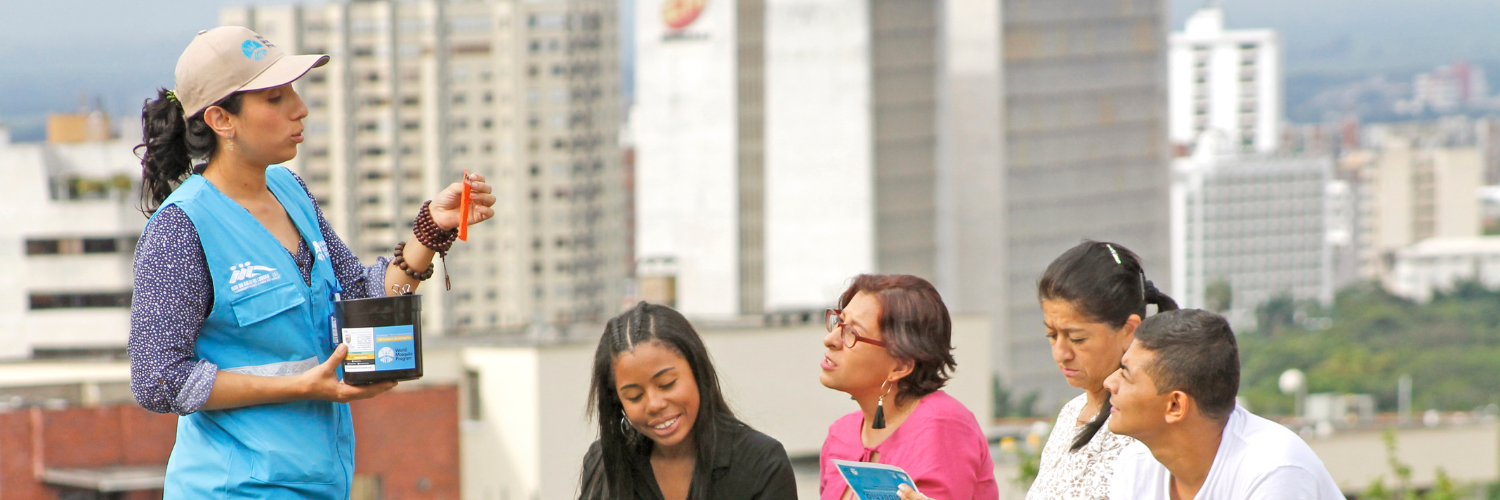Kami sering mengatakan bahwa 'pelibatan masyarakat adalah inti dari apa yang kami lakukan'. Namun, mengapa hal ini begitu penting dan apa sebenarnya artinya?
Makalah yang baru saja diterbitkan ini yang dibuat oleh tim Komunikasi dan Keterlibatan kami di Brasil ini menjelaskan kerangka kerja untuk melibatkan masyarakat di Brasil selama penerapan metode Wolbachia metode ini dalam skala besar di Niterói dan Rio de Janeiro.
Hal ini menjelaskan bahwa setiap upaya untuk mengendalikan penyebaran penyakit yang ditularkan oleh nyamuk akan membutuhkan transparansi dengan orang-orang yang terkena dampak, dan tentu saja partisipasi aktif mereka. Menghilangkan tempat berkembang biak, misalnya, mengharuskan penduduk untuk mencegah dan menghilangkan genangan air di dalam dan di sekitar rumah mereka. Dalam kasus kami, partisipasi masyarakat biasanya dalam bentuk:
- pelepasan Wolbachia membawa nyamuk
- pemeliharaan Wolbachia telur nyamuk
- menjadi tuan rumah dan memantau perangkap nyamuk
- membentuk komite lokal untuk memantau kemajuan dan memfasilitasi diskusi
Seperti yang ditunjukkan oleh makalah ini, keterlibatan yang sukses adalah tentang 'pertukaran'.
"Dengan dialog, orang berpikir bersama yang mengasumsikan bahwa peserta dialog memahami bahwa posisinya bukanlah yang terakhir... Hal ini membutuhkan kapasitas yang mendalam untuk mendengarkan."
Lebih dari sekadar memberikan informasi dan meminta persetujuan masyarakat, pelibatan masyarakat harus membuka peluang dialog terbuka antara berbagai pemangku kepentingan untuk memungkinkan kerja sama demi kebaikan bersama. Bagaimanapun juga, masyarakat yang bekerja sama dengan kami bukanlah penerima pasif, melainkan pemain kunci dalam peningkatan lingkungan kesehatan masyarakat mereka sendiri.
Pada akhir tahun 2019, proyek kami di Brasil telah menjangkau sekitar 1,2 juta orang. Tiga area penting dalam masyarakat menjadi sasaran dalam upaya awal untuk menginformasikan dan melibatkan mereka; sekolah umum, sektor kesehatan, dan pemimpin sosial. Ketiga bidang ini dipilih karena pemahaman mereka yang mendalam tentang lanskap sosial setempat dan jaringan potensial yang dapat mereka bangun.
Dalam kasus sekolah, misalnya, tim kami di Brasil membuat e-book, beberapa video, pamflet, poster, dan platform digital untuk digunakan oleh para guru di kelas. Dalam beberapa kasus, pemantauan dan studi tentang perkembangan nyamuk dimasukkan ke dalam kurikulum sekolah dengan menggunakan sumber daya yang disediakan oleh WMP.
Di sektor kesehatan, lebih dari 1000 tenaga kesehatan dilatih dan 62 grup WhatsApp dibuat untuk membantu penyebaran informasi dan sebagai sarana untuk berdiskusi.
Komponen kunci lain dari strategi pelibatan masyarakat adalah pembentukan Kelompok Referensi Masyarakat. Dalam sesi kelompok ini, para peserta sukarelawan bebas untuk berdebat, bertanya, mengkritik, dan memberikan saran. Kelompok-kelompok ini menyediakan platform untuk berdialog antara perwakilan masyarakat, ilmuwan, profesional kesehatan, dan staf WMP .
Dan hal ini berlaku dua arah. Kelompok-kelompok tersebut juga memberikan referensi yang berharga bagi tim WMP kami untuk memahami kekhawatiran dan keterbatasan utama sebelum melakukan rilis. Mereka menyoroti dinamika budaya di wilayah tersebut dan memungkinkan kami untuk memikirkan kembali, menyesuaikan diri, dan menawarkan akses yang lebih baik ke informasi yang lebih jelas.
Orang-orang yang tinggal di tempat-tempat di mana nyamuk menyebarkan penyakit menghadapi beberapa tantangan berat. Pembangunan perkotaan yang tidak terencana, perubahan penggunaan lahan, dampak perubahan iklim, peningkatan mobilitas internasional, semuanya membantu penyebaran arbovirus. Satu-satunya jalan menuju keberhasilan melawan mereka adalah kerja sama. Bekerja sama di semua tingkat masyarakat. Kami memiliki solusi, kami memiliki ilmu pengetahuan dan kami yakin kami memiliki model untuk melengkapi orang-orang yang paling berisiko dengan alat untuk melindungi diri mereka sendiri secara efektif


